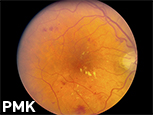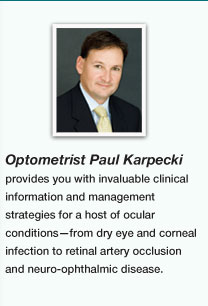 |
|
A third nerve palsy typically presents with a ptosis and diplopia (upon eyelid lifting) secondary to motility restriction, as well as limited elevation. The underlying cause often may be differentiated by pupillary appearance. Generally speaking, if the pupil is dilated, you likely should consider the existence of more serious neurological conditions, such as a space–occupying lesion or an aneurysm. More specifically, a third nerve palsy with a blown pupil, combined with a significant headache, requires prompt referral to a neurologist/neurosurgeon for an imaging study.
On the other hand, patients may experience pain and a dilated pupil associated with a third nerve palsy secondary to diabetes, hypertension or another microvascular condition. In this setting, patients typically still exhibit some pupillary constriction upon direct light exposure. By contrast, patients with neurologically induced palsies typically won’t exhibit pupillary constriction under any circumstance.
Again—in cases of third nerve palsy in which the pupil is normal, and the patient has a documented history of diabetes and no contributory neurological findings, the underlying cause likely is microvascular in nature. Although diabetes seems to be the most common underlying systemic disease, other conditions, such as hypertension or atherosclerosis, also could cause a microvascular third nerve palsy.
If other findings, such as color vision abnormalities, severe headaches and pain, or a dilated pupil are detected, there can be a risk for stroke or a comorbidity associated with diabetes. So, always rule out such ancillary neurological findings, regardless of how the third nerve palsy presents.
If no neurological findings are documented, continue to monitor the presentation and educate the patient on your findings. Such nerve palsies are transient in nature, and should resolve within two to three months, or sooner. If symptoms do not resolve, or a new neurological finding manifests, referral for imaging is advised.
|
 |







![]()